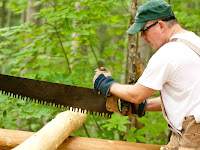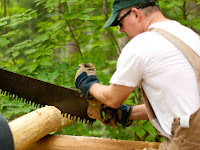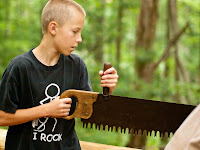I called Mr. R.O. Wilson to introduce myself and ask him about my saw. The master sharpener asked, two minutes into the conversation, "Now son, who is this?"
"Mr. Wilson, I'm a neighbor. I live across a couple of ridges from where you live in Cullowhee Mountain. Up a holler. I have a saw, and from what I hear you might be the only man in these parts who can sharpen it. Would you be willing to take a look at it?"
He asked me if it had one handle or two, its length, and what the teeth looked like. "What you have there is a buck saw." This is true. My saw is designed for use by one man, although you could put a handle on the other end. It's a bit thicker than a typical, two-handled felling saw, so it can be pushed as well as pulled. For me, it's much more useful -- it can be used to buck trees into logs, cut firewood, or cut the logs I'm working into cabin walls.
Mr. Wilson didn't say much more but invited me to come by any evening with my saw. Like other older generation mountain folk I've gotten to know since we moved here, he wouldn't lock in a date or time. It's tough for a schedule-oriented person when arranging for tree work, or gravel delivery, or firewood, or a similar service, although I still prefer working with local folk and mostly enjoy it. This must be a holdover from a slower era, before modern, commitment-heavy lifestyles infiltrated rural societies like Jackson County, as a greater variety of employment, entertainment, social and recreational opportunities, and people climbed up into the small towns, valley communities, coves, hollers and even ridge tops. Like kudzu, covering up the landscape, cloaking or muting the old ways of being. I guess when an early rise, a hard day at work, supper, bedtime, gardening on Saturday, and church on Sunday were the only main punctuation marks in a typical week, it was normal to issue open invitations; or maybe, shunning concrete appointments is a way to preserve a sense of personal freedom.
I pulled up to an old barn in my truck and asked a couple of aging men for directions to the old man's house, up the holler. One asked me to "set a spell" and said he was R.O.'s brother. I thanked this Mr. Wilson who said, "Young man, I'm not Mr. Wilson. He's Mr. Wilson."
Mr. Wilson came to his door, exited the house, and led me to a bench in the shade of a tree. He's taller than me, with a white mustache and a farmer's hunch. I learned that he had recently gone blind in one eye, that things were harder for him to do. He looked at my saw but didn't say much. It was obvious that he didn't care for it. He looked at the lack of set, the blunt teeth. "That's one of those off-brand saws," he muttered. He said he could maybe work on it a bit but didn't give a time or say how long it would take. I looked disappointed. Then he said, "But I might have one I could sell to you."
Owning one of Mr. Wilson's personal saws would be very satisfying. First, maybe it would be an item of perfection, a prized tool, expertly set and sharpened. Second, it would have to cut better than mine. Third, I liked and respected him and felt honored by the offer. "Yes sir," I said, "I would be very interested in seeing your saws."
We went up to the shed, next to the corn, in the sun, behind his house. Inside, it was like an oven, hot and still, anything metal ready to sear hair or pierce your hide and cauterize the wound in the same instant. There was an antique, long wooden saw vice on a bench, but I couldn't see his sharpening tools, jigs and files. Behind the bench maybe five or six saws hung, long two-handled felling saws, shorter but still sizable buck saws, and some types I couldn't name. He reached up and pulled down a buck saw, maybe 50 inches or so long, dark, oiled blade, an intact handle with a peg handle above it. He looked at it for minute and handed it to me. The teeth were like razors, and the set was subtle but distinct. We walked over to a large log on sawbucks. "That's rotten so you won't get the shavings, but try it out." I did -- the saw took no backtalk from the big log, although in green wood it would crisply sing. "Let the saw do the work. See the way it goes?" I quit driving and pulling it straight, allowing it to rise and fall with the contour of the teeth. "You'll do. You'll figure that out right straight." Thanks for that, Mr. Wilson. Means a lot more than being able to cut wood.
I drove back to the ATM at Western to get the gentleman his money. When I returned, he was frying the okra I'd brought him, that came from my inlaws' garden down near the Pee Dee River, in lowcountry South Carolina. He said it was tender, and I thanked him for the saw.
Click HERE to read part 3.
Here are some pictures of the saw in use, up at the cabin, taken by David Despeaux. Click on any picture to enlarge it and see detail:





















